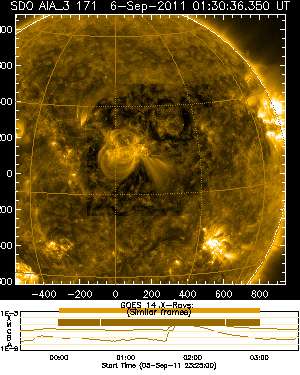Moderate Labor Day solar flare eruption

At 9:35 PM ET on September 5, 2011, the sun emitted an Earth-directed M5.3 class flare as measured by the GOES satellite. The flare erupted from a region of the sun that appears close to dead center from Earth's perspective, an active region designated number 1283. The flare caused a slight increase of solar energetic protons some 26,000 miles above Earth's surface.
A coronal mass ejection (CME) -- another solar phenomenon that can send solar particles into space -- was associated with this flare. The CME is a relatively slow one, traveling at under 200 miles per second.
Further updates on the event will be provided as they become available.
More information: What is a solar flare? What is a coronal mass ejection?
For answers to these and other space weather questions, please visit the Spaceweather Frequently Asked Questions page.
Provided by JPL/NASA





















